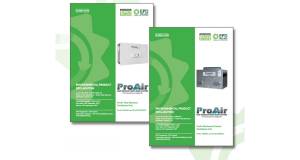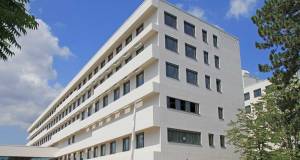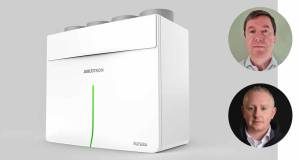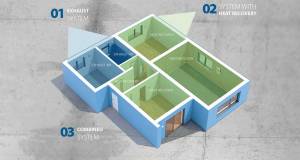- Ventilation
- Posted
Breathe Easy

A recent study instigated by the American Environmental Protection Agency has identified indoor air quality as one of the top five urgent environmental risks to public health. The problem of indoor air pollution is largely avoidable through the implementation of sufficient ventilation, yet many of us choose to ignore the seriousness of the issue, and fall short of the requirements of Part F1 of the building regulations, taking heed only when visible structural problems such as moisture and damp arise. However, given the increasing onus on human health, as manifested in Minister for Health Micheal Martin’s imminent ban on smoking in pubs, there is mounting pressure on the construction industry to deliver buildings with a sound interior air quality that does not pose a threat to the health of occupants. The implications of poor ventilation are potentially life threatening and can result in fatal asthma or lung cancer.
Health Implications
It is hardly surprising that, as a people who spend up to 90% of our time indoors Irish people are almost constantly exposed to some form of indoor pollutant. Naturally occurring pollutants such as dust mites, fungus and mould thrive in Ireland, and rapidly occur when there is dampness in a structure and a relative humidity of or in excess of 70%. Something as essential as breathing, and everyday functions such as cooking, bathing, dishwashing, washing and drying clothes, and heating buildings, can create up to 5 Kg of moisture per day independently adding to an already humid indoor environment.
Health problems such as eye and throat allergies, asthma, headaches, tiredness, coughing, wheezing, and even mental confusion can result from cases of high humidity, and are also triggered by unventilated residue, emanating from pets, dusty window coverings, bed linen, cigarette smoke, pollen, mouldy plant soil, and firewood (which can generate problematic mould spores when damp). Furthermore, chemical sources of indoor pollution, as can be found in many building materials, paints, varnishes, electronic equipment, photocopiers and printers, cleaning fluids, and polishes commonly cause headaches, breathing problems and allergies, and can even prove fatal at extreme levels.
Radon gas is perhaps one of the most dangerous indoor pollutants, as it is colourless and odourless, making it impossible to detect without the intervention of experts. Radon occurs naturally, and is emitted through ground cracks beneath a building. If left undetected it is possible that the radon will reach levels well in excess of the legally permitted levels (400 BQ.M3 for the work place, 200 BQ.M3 for the general public), in which case the likelihood of contracting lung cancer will be dramatically increased. Radon can occur anywhere, and as such all buildings should take appropriate precautions. Ventilation fixed to expel the gas at ground level, in conjunction with effective floor sealing can effectively combat the problem.
From a health perspective the main objective of ventilation, is to keep the level of pollutants in buildings at an acceptably low level. Through employing the correct ventilation techniques it is possible to drastically reduce building related illnesses and provide a healthy interior environment.
While the health of occupants should be an essential requirement of a building, this should be allied with evaluating the structural elements and ensuring the stability of the structure. The impact of poor ventilation on a structure is likely to cause considerable damage over time, leading to problems such as excessive moisture, damp stains, smoke stains on structural surfaces, build up of dirt, condensation and deterioration of décor. Though the results of some of these problems may initially seem only superficially detrimental, the long term effects can cause serious problems. It is costly to repair damage caused directly as a result of poor ventilation and it can be dangerous to leave the problem untreated. Structures under the pressures of poor ventilation are prone to weakening and can prove unsafe as surfaces eventually rot and dilapidate.
Indeed, the increasing stress on high insulation standards in virtually all types of building places a growing emphasis on proper ventilation. The benefits of seeking advice from experts cannot be understated, given the various criteria buildings are obliged to fulfil. In this regard, the most efficient and effective ventilation system, to suit the needs of a particular building, should be installed. It is also important to keep timber floors well ventilated, as this will prevent dampness and reduce energy consumption caused by irregular airflow. Loft ventilation and ventilation for appliances are also essential. Loft ventilation serves to diminish moisture build up in the ceiling, whilst the ventilation of appliances such as gas cookers and paraffin heaters prevents the release of dangerous gases into a structure’s habitable environment.
The Regulations
The current building regulations for ventilation, Part F1, stresses that the main functions of a ventilation system on a general level should:
‘provide an adequate supply of fresh air for using an area or building; achieve occasional rapid ventilation for dilution of pollutants and of moisture likely to produce condensation in habitable rooms, kitchens and rooms containing sanitary appliances; and extract moisture from areas such as kitchens and bathrooms, where it is produced in significant quantities’.

The Systems
When selecting a ventilation system best suited to an individual structure there are many options to consider. Natural ventilation includes systems such as trickle ventilation, passive stack ventilation (PSV), fan assisted and wind tower ventilators. The simplest form of natural ventilation is to open a window. However this is generally only suitably effective when combined with a ventilation system. Mechanical ventilation systems typically installed in poorly ventilated Irish buildings include mechanical extract systems, mechanical supply systems, and mechanical ventilation systems with heat recovery (MVHR). Additional dehumidifying systems are also often installed to prevent the build up of moisture in a structure and control humidity levels.
Natural ventilation is dependent upon temperature levels and wind pressure in order to operate efficiently, as air is required to circulate through the ventilated structure. The most basic form of natural ventilation; opening windows, helps to banish odours from rooms such as kitchens and bathrooms, and can provide comfort during warm summer days, through a constant flow of fresh air. The most effective way of keeping timber frame buildings cool in summer is to leave windows closed during the day and open at night.
Trickle ventilation is most commonly used to prevent condensation and reduce humidity. The system is simply a series of small openings set into a window frame in order to provide permanent air flow and wind pressure regulation. Trickle ventilation systems are best installed in all habitable rooms of a building and can also be fitted to wet rooms as an alternative to another form of ventilation such as PSV.
Passive Stack Ventilation (PSV) is an effective system used to extract moisture and control humidity in kitchens and bathrooms, through the reliance on a sufficient air supply from another source. PSV is particularly attractive from an environmentally conscious point of view as it is simple and energy efficient when correctly installed.
Fan assisted PSV differs from PSV only in that a low powered fan of approximately 40W is added to enable the general system to run on a site where its performance would otherwise be restricted.
Wind tower ventilators, another natural ventilation system, function in a similar way to the general PSV system. They differ in that they tend to be of a larger size, and possess an altered internal mechanism. Wind tower ventilators do not rely specifically on an alternative source of air supply and are typically installed in small open structures such as public halls.
Mechanical Extract Systems are the most basic of the mechanical ventilation systems and provide practical ventilation whenever needed. These systems are best suited to wet areas that lack opening windows, such as kitchens, bathrooms and WCs.
They extract odours and moisture and are popular due to being reasonably energy efficient and having a long lifespan in comparison with traditional fans.
In contrast to typical extract systems, mechanical supply systems work to deliver ventilation through the release of air taken from an uninhabited area of a structure. These systems are often used in existing buildings that suffer from condensation and are low in power usage, which ultimately makes these systems effective and energy efficient.
Finally, mechanical ventilation systems with heat recovery (MVHR) differ from the other mechanical systems in that they are able to reclaim heat that would otherwise be lost through the ventilation. MVHRs ‘extract’ heat from wet rooms and ‘supply’ it to dry rooms. They control humidity, and can be installed as a system for an entire building or instead as individual room units. MVHRs are extremely effective, especially during winter months, and can run continuously for periods exceeding six months.
It is valuable that the consumer talks to an expert prior to the installation of a system, in order to make the most of the system and conserve energy. Good ventilation is a fundamental requirement for a building to be fit for occupation, and can play a vital role in securing the health of occupants, the structure, and ultimately the value of a building.
Further Reading: the Green Building Handbook, Volumes 1 & 2, edited by Tom Woolley, Sam Kimmins et al, published by Spon Press. Available at www.sponpress.com
- Ventilation
- indoor air quality
- Part F1 of the building regulations
- Health
- breathing
- indoor environment
- unventilated residue
- indoor pollution
- sustainable building
- ventilation techniques
Related items
-
 Enniscorthy to host ‘make or break’ sustainable building summit
Enniscorthy to host ‘make or break’ sustainable building summit -
 Lung disease patient: Zehnder MVHR “the best thing I’ve ever had”
Lung disease patient: Zehnder MVHR “the best thing I’ve ever had” -
 Why airtightness, moisture and ventilation matter for passive house
Why airtightness, moisture and ventilation matter for passive house -
Awaab Ishak’s death shows that building physics are a life and death matter
-
 ProAir pioneers with EPDs for ventilation systems
ProAir pioneers with EPDs for ventilation systems -
 World’s first passive house hospital completed in Frankfurt
World’s first passive house hospital completed in Frankfurt -
 Let’s bring ventilation in from the cold
Let’s bring ventilation in from the cold -
 45,000 more Irish homes face radon risk, new maps reveal
45,000 more Irish homes face radon risk, new maps reveal -
 ProAir retooling for the future
ProAir retooling for the future -
 Ecological launch Inventer decentralised ventilation
Ecological launch Inventer decentralised ventilation -
 Poor ventilation a Covid risk in 40 per cent of classrooms, study finds
Poor ventilation a Covid risk in 40 per cent of classrooms, study finds -
 Efficient ventilation key to healthier indoor spaces – Partel
Efficient ventilation key to healthier indoor spaces – Partel

